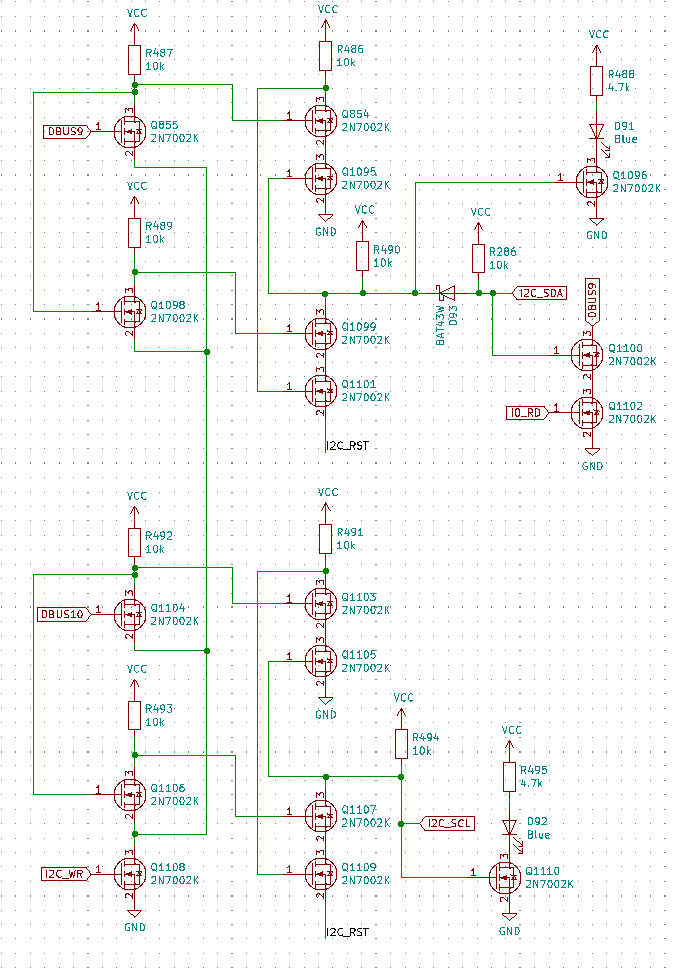I should have my test board for the 2SK3018 transistors back next week, but in the meantime I've been thinking about other changes.
In the interest of adding more I/O capabilities, I think I've settled on adding an I2C interface to the Q2. I2C is pretty easy to support, requiring 2 open-drain outputs (SDA for data and SCL for a clock), and an input (only SDA assuming there isn't a need for clock stretching).
To implement the output for I2C is the most complicated, requiring a latch for SDA and SCL. Input is easy, requiring only a single NAND gate. Here's the current proposal:

The idea is that bit 11 of address 0xFFF will select between the LCD (0) and I2C (1), allowing easy access to the LCD just as before. When bit 11 is set, bit 10 sets SCL and bit 9 sets SDA. The software for I2C is fairly simple. For start/stop, I think something like this should work:
.def I2C_EN 0x800 .def I2C_SCL 0x400 .def I2C_SDA 0x200 ; Note I2C signals are inverted. i2c_zero: .dw I2C_EN | I2C_SDA | I2C_SCL i2c_zero_clk: .dw I2C_EN | I2C_SDA i2c_one: .dw I2C_EN | I2C_SCL i2c_one_clk: .dw I2C_EN i2c_input_mask: .dw ~I2C_SDA ; Send I2C start ; Take SDA low while SCL stays high. i2c_start: sta =x1 lda i2c_one_clk ; SDA=1, CLK=1 sta @=neg1 lda i2c_zero_clk ; SDA=0, CLK=1 sta @=neg1 jmp @=x1 ; Send I2C stop ; Take SDA high while SCL stays high. i2c_stop: sta =x1 lda i2c_zero_clk ; SDA=0, CLK=1 sta @=neg1 lda i2c_one_clk ; SDA=1, CLK=1 sta @=neg1 jmp @=x1
For writing, we just loop over each bit. Being a 12-bit architecture, we have to shift off 4 bits first. So, something like:
; Write byte in x0. ; Destroys x0-x2 i2c_write: sta =x1 ; Shift out high 4 bits lda =x0 add =x0 sta =x0 ; x2 add =x0 sta =x0 ; x4 add =x0 sta =x0 ; x8 add =x0 sta =x0 ; x16 lea =8 i2c_write_loop: add =neg1 sta =x2 lda =x0 add =x0 sta =x0 jfc i2c_write_zero ; Write 1 lda i2c_one sta @=neg1 lda i2c_one_clk sta @=neg1 lda i2c_one jmp i2c_write_cont i2c_write_zero: ; Write 0 lda i2c_zero sta @=neg1 lda i2c_zero_clk sta @=neg1 lda i2c_zero i2c_write_cont: sta @=neg1 lda =x2 jfc i2c_write_loop ; Acknowledge lda i2c_one sta @=neg1 lda i2c_one_clk sta @=neg1 lda i2c_one sta @=neg1 jmp @=x1
Reading is similar. From simulation, this would make reading 256 bytes from an EEPROM take somewhere in the neighborhood of 26 seconds at a 80kHz clock. It would be nice to get this faster, but that's plenty fast to use some I2C sensors or a real-time clock, etc.
 Joe Wingbermuehle
Joe Wingbermuehle
Discussions
Become a Hackaday.io Member
Create an account to leave a comment. Already have an account? Log In.